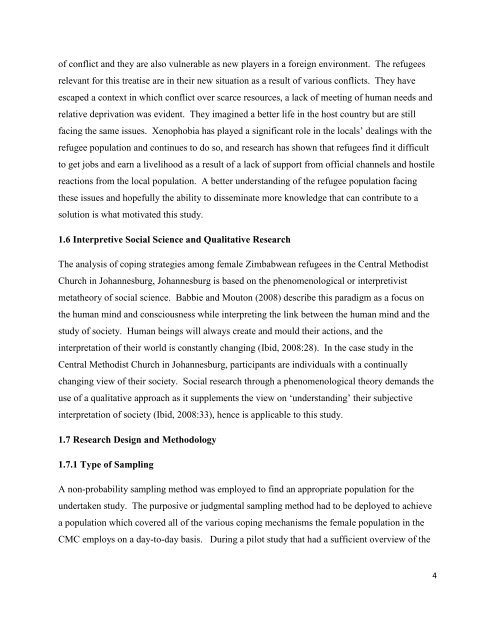Guro Lauvland Bjorknes.pdf - NMMU
Guro Lauvland Bjorknes.pdf - NMMU
Guro Lauvland Bjorknes.pdf - NMMU
You also want an ePaper? Increase the reach of your titles
YUMPU automatically turns print PDFs into web optimized ePapers that Google loves.
of conflict and they are also vulnerable as new players in a foreign environment. The refugees<br />
relevant for this treatise are in their new situation as a result of various conflicts. They have<br />
escaped a context in which conflict over scarce resources, a lack of meeting of human needs and<br />
relative deprivation was evident. They imagined a better life in the host country but are still<br />
facing the same issues. Xenophobia has played a significant role in the locals‟ dealings with the<br />
refugee population and continues to do so, and research has shown that refugees find it difficult<br />
to get jobs and earn a livelihood as a result of a lack of support from official channels and hostile<br />
reactions from the local population. A better understanding of the refugee population facing<br />
these issues and hopefully the ability to disseminate more knowledge that can contribute to a<br />
solution is what motivated this study.<br />
1.6 Interpretive Social Science and Qualitative Research<br />
The analysis of coping strategies among female Zimbabwean refugees in the Central Methodist<br />
Church in Johannesburg, Johannesburg is based on the phenomenological or interpretivist<br />
metatheory of social science. Babbie and Mouton (2008) describe this paradigm as a focus on<br />
the human mind and consciousness while interpreting the link between the human mind and the<br />
study of society. Human beings will always create and mould their actions, and the<br />
interpretation of their world is constantly changing (Ibid, 2008:28). In the case study in the<br />
Central Methodist Church in Johannesburg, participants are individuals with a continually<br />
changing view of their society. Social research through a phenomenological theory demands the<br />
use of a qualitative approach as it supplements the view on „understanding‟ their subjective<br />
interpretation of society (Ibid, 2008:33), hence is applicable to this study.<br />
1.7 Research Design and Methodology<br />
1.7.1 Type of Sampling<br />
A non-probability sampling method was employed to find an appropriate population for the<br />
undertaken study. The purposive or judgmental sampling method had to be deployed to achieve<br />
a population which covered all of the various coping mechanisms the female population in the<br />
CMC employs on a day-to-day basis. During a pilot study that had a sufficient overview of the<br />
4
















